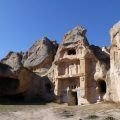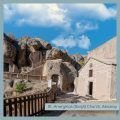Cappadocia is a unique and beautiful region in Turkey that is renowned for its ancient and fascinating cave dwellings, underground cities, and majestic rock formations. However, one of its most intriguing features is the abundance of cave paintings that can be found throughout the region.
The cave paintings of Cappadocia are believed to have been created between the 6th and 10th centuries by early Christian communities that lived in the area. These paintings were made on the walls and ceilings of natural caves and underground shelters that were used as living quarters, churches, and monasteries.
The cave paintings of Cappadocia are considered to be some of the finest examples of Byzantine art in the world. They are characterized by their vibrant colors, intricate designs, and religious themes. Many of the paintings depict scenes from the Bible, such as the Nativity, the Crucifixion, and the Last Judgment, while others depict everyday life, such as hunting and farming.
One of the most famous locations for viewing cave paintings in Cappadocia is the Göreme Open Air Museum. This UNESCO World Heritage Site is home to a collection of cave churches and monasteries that are adorned with stunning frescoes and murals. The most famous of these is the Dark Church, which is named for its lack of windows and is home to some of the most intricate and well-preserved cave paintings in the world.

Another popular location for viewing cave paintings in Cappadocia is the Zelve Open Air Museum. This site was once a thriving cave community, and today visitors can explore the abandoned cave homes and churches that are adorned with beautiful paintings and frescoes.
In addition to the Göreme and Zelve Open Air Museums, there are also many other locations throughout Cappadocia where visitors can view cave paintings. Some of the most impressive examples can be found in the underground cities of Derinkuyu and Kaymakli, which were used as hiding places by early Christians during times of persecution.
It is important to note that many of the cave paintings in Cappadocia are very fragile and susceptible to damage from light, humidity, and human touch. As such, visitors are typically not allowed to touch or photograph the paintings, and are often required to wear protective clothing and follow strict rules in order to preserve these valuable artifacts.
In conclusion, the cave paintings of Cappadocia are a testament to the region’s rich cultural and religious history. These beautiful and intricate works of art provide a fascinating glimpse into the lives of the early Christian communities that once inhabited this remarkable region, and are a must-see for anyone interested in history, art, or culture.




